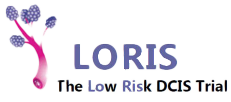Principal Investigator - Prof Val Jenkins
Principal Investigator - Prof Dame Lesley Fallowfield
Researcher - Lucy Matthews
Data Manager - Shirley May
Funder: NIHR HTA
Sponsor: University of Birmingham

The introduction of the mammographic breast screening programme in the UK resulted in a dramatic increase in the diagnosis of Ductal Carcinoma in situ (DCIS). DCIS accounts for approximately 20% of breast 'cancers' detected by breast screening. A diagnosis of DCIS means there are abnormal cells in the milk ducts of the breast that have not invaded the surrounding breast tissue.
DCIS is visualised as specks of white (calcium) seen on mammograms. Pathologically it can be divided into 3 grades - high, intermediate or low. High grade DCIS is more likely to turn into breast cancer, and so it is treated as though it is breast cancer. Low and low/intermediate grade DCIS is different and doctors are uncertain if it would ever become invasive breast cancer. Currently, all DCIS is treated by surgery.
Between August 2014 and March 2020, the Low Risk DCIS (LORIS) Trial recruited 181 patients with low or intermediate grade DCIS. Patients were randomised to either no surgical intervention (active monitoring) or standard treatment which is surgery.
Quality of life (QoL) is a secondary outcome measure of the LORIS Trial. Participants completed baseline QoL questionnaires prior to randomisation. Then 3 times a year (3, 6 & 12 months) for the first year and then annually until 5 years.
The questionnaires asked about:
- Decision to join or reject the trial
- Psychological adjustment - anxiety trait and ways of coping
In addition, the impact that either active monitoring or surgery had on:
- Anxiety state
- General well-being
A subset of patients participated in a telephone interview to explore their feelings about the trial.
The QoL data are being analysed and will be published in 2026.
Current Stage:
Analysis and Write Up
Publication
Time for a low-risk DCIS trial: harnessing public and patient involvement https://doi.org/10.1016/S1470-2045(12)70503-XPublication
Low Grade Ductal Carcinoma in Situ (DCIS): How best to describe it? https://doi.org/10.1016/j.breast.2014.06.013Publication
The LORIS Trial: Addressing Overtreatment of Ductal Carcinoma in Situ https://doi.org/10.1016/j.clon.2014.09.015Publication
Addressing overtreatment of screen detected DCIS; The LORIS Trial https://doi.org/10.1016/j.ejca.2015.07.017Publication
Overtreatment of Low-Grade Ductal Carcinoma In Situ https://doi.org/10.1001/jamaoncol.2015.5026Publication
Confusion Over Differences in Registration and Randomization Criteria for the LORIS (Low-Risk DCIS) Trial. https://doi.org/10.1245/s10434-017-6174-yPublication
Recruiting women with Ductal Carcinoma In Situ to a randomised clinical trial: lessons from the LORIS study https://doi.org/10.1186/s13063-023-07703-4Poster
Interviews with women contemplating LORIS trial entry: 2 year feasibility study posters/LORISnov22.pdf Presented at San Antonio Breast Cancer Symposium 2017Poster
The challenges of recruiting women with low-risk ductal carcinoma in situ to a randomised controlled trial: the LORIS study experience posters/LORIS_Poster_19Dec2023.pdf
